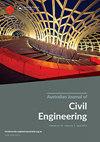Development and evaluation of a novel geopolymer based on basalt rock waste and ground granulated blast furnace slag
IF 1.6
Q3 ENGINEERING, CIVIL
引用次数: 3
Abstract
ABSTRACT Increase in industrial and construction activities has led to an enormous rise in waste generation and its hazardous impacts on the environment. Quarrying of rocks and manufacturing of artificial sands for civil engineering projects leads to the dumping of rock waste dust, which is a source of landfill problems. Further, excessive energy requirements for cement manufacturing, higher greenhouse gas emissions and rapid depletion of natural resources have focused the research towards the development of environment friendly and sustainable materials such as geopolymers. In this paper, a novel geopolymer has been developed from industrial wastes such as basalt rock fines considering partial replacement with ground granulated blast furnace slag up to 30%. After a detailed mix-design investigation, the optimum molarity (M) of the sodium hydroxide solution was found to be 8 M whereas the optimum ratio (R) of sodium silicate to sodium hydroxide solution as 0.75. Unconfined compressive strength evaluation showed 7-day strengths up to 34 MPa, comparable to geopolymers based on conventional precursor materials. The scanning electron microscopy imaging of the specimens revealed a dense geopolymer gel formation resulting in a homogeneous microstructure. As a result, this innovative material produced can be used as an alternative, sustainable and cost-effective construction material.以玄武岩废石和高炉矿渣为原料的新型地聚合物的研制与评价
摘要工业和建筑活动的增加导致废物产生及其对环境的有害影响大幅增加。土木工程项目的岩石采石和人造砂制造导致了岩石废料粉尘的倾倒,这是垃圾填埋问题的根源之一。此外,水泥制造业对能源的过度需求、温室气体排放量的增加和自然资源的快速消耗,使研究集中在开发地质聚合物等环境友好和可持续的材料上。本文从玄武岩等工业废物中开发了一种新型地质聚合物,考虑用高达30%的磨细高炉矿渣部分替代。经过详细的配合比设计研究,发现氢氧化钠溶液的最佳摩尔浓度(M)为8M,而硅酸钠与氢氧化钠溶液的最优比例(R)为0.75。无侧限抗压强度评估显示,7天强度高达34MPa,与基于传统前体材料的地质聚合物相当。样品的扫描电子显微镜成像显示,形成了致密的地质聚合物凝胶,形成了均匀的微观结构。因此,生产的这种创新材料可以用作替代、可持续和成本效益高的建筑材料。
本文章由计算机程序翻译,如有差异,请以英文原文为准。
求助全文
约1分钟内获得全文
求助全文

 求助内容:
求助内容: 应助结果提醒方式:
应助结果提醒方式:


